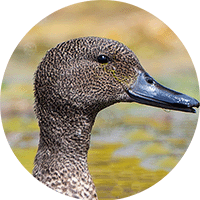Andean Teal
Appearance: The Andean Teal male has a dark grey plumage with a chestnut head and neck, while the female is mottled brown with a whitish throat and face. Both sexes have a bright red eye and a striking powder-blue speculum or wing patch.
Habitat: The Andean Teal is found in high-altitude wetland habitats such as lakes, ponds, and marshes in the Andean region. They prefer areas with abundant emergent vegetation and open water for feeding and nesting.
Behavior: The Andean Teal is a social bird that forms small flocks outside of the breeding season. They are dabbling ducks, feeding by tipping forward in shallow waters to reach aquatic plants, seeds, and invertebrates. They are observed swimming and foraging for food in a group.
Breeding: During the breeding season, which occurs from October to December in the Andean region, pairs of Andean Teals will establish nesting territories near suitable wetland habitats. The female constructs the nest on the ground among vegetation, where she lays a clutch of around 6-10 eggs. Both parents participate in incubating the eggs and caring for the ducklings after hatching.
Conservation Status: The Andean Teal is not listed as globally threatened.
Distribution
Andean Highlands: The Andean Teal is typically found in the high-altitude regions of the Colombian Andes. It inhabits the montane forests, cloud forests, paramo ecosystems, and other wetland habitats found in the Andean Highlands. This species is well adapted to the cool and mountainous environments of this region.
Mountainous Regions: The Andean Teal can be observed in various mountain ranges of Colombia, including the Central Andes, Eastern Andes, and Western Andes. These mountainous regions provide suitable habitats with ample water bodies for the ducks to thrive.
- Wetlands and Lakes: Wetlands and lakes located in the Andean regions of Colombia serve as important habitats for the Andean Teal. They prefer areas with freshwater bodies such as lakes, marshes, ponds, and slow-flowing rivers. These habitats provide feeding opportunities and nesting sites for the species.
- Altitudinal Range: The Andean Teal is capable of inhabiting a wide altitudinal range, typically between 2000 to 4000 meters (6,500 to 13,200 feet) above sea level in Colombia's Andean region.
Taxonomy
- Kingdom: Animalia
- Phylum: Chordata
- Class: Aves
- Order: Anseriformes
- Family: Anatidae
- Genus: Anas
- Species: Anas andium
Vocalization
The Andean Teal has a distinctive vocalization that consists of a whistling call. The male's call is typically a clear and high-pitched whistle, often described as a "whee-oo" or "wheet-wheet." This call is often produced during flight or while the ducks are in water. It serves as a territorial and contact call, helping individuals communicate with each other and maintain group cohesion.
The female's vocalization is usually softer and less distinct compared to the males. However, they can also produce similar whistling calls, albeit with less intensity and lower frequency. The vocalizations of the Andean Teal are an important part of their social behavior and communication within their group.





